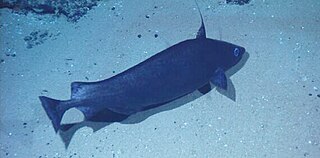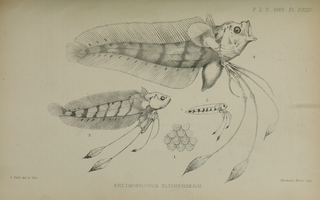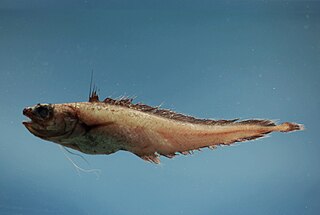
The Moridae are a family of cod-like fishes, known as codlings, hakelings, and moras.

The blue antimora, also known as the flat-nose codling, blue hake, long-finned cod or violet cod, is a benthopelagic species of morid cod of the genus Antimora, found in seas around the world on the continental shelf except the north Pacific. This bluish-black species may be found at depths of between 350 and 3,000 m(1,148 to 9.843 ft), but it is commonly found at depths of 800-1800m. Its length is between 40 and 75 cm. It is of minor importance to commercial fisheries.
The slender codling or slender cod is a morid cod, the only species in the genus Halargyreus. It is found in all oceans, at depths from 450 to 3,000 m, and grows to 56 cm (22 in) in total length. First discovered by and named after James Yate Johnson.

The northern bastard codling is a morid cod of the genus Pseudophycis, found around southern Australia including Tasmania, and New Zealand, from the surface to 220 m. Its length is between 15 and 25 cm.

The southern bastard codling or bearded red cod is a morid cod of the genus Pseudophycis, found around southern Australia including Tasmania, and New Zealand, from the surface to 300 m. Its length is up to 63 cm.

The red codling or hoka is a morid cod of the genus Pseudophycis, restricted to New Zealand, from the surface to 700 m. A closely related species, Pseudophycis barbata, is found in Australia. It reaches lengths up to 90 cm. P. bachus is a food source for the diving yellow-eyed penguin, Megadyptes antipodes.
The dwarf codling(Notophycis marginata), is a species of morid cod found on the continental slopes in the southeast Pacific and the southwest Atlantic, where it is found down to 1,200 m (3,900 ft). This species grows to 24 cm (9.4 in) in total length.

Pseudophycis is a genus of codlings of the family Moridae found around New Zealand and Southern Australia.

Physiculus is a genus of morid cods.

Centroberyx, often referred to as nannygais, is a genus of ray-finned fishes found in the Indian Ocean and western Pacific Ocean, with its greatest species richness off southern Australia. They are reddish in colour and somewhat resemble the related soldierfish. Depending on species, they may have a maximum length of 20 to 66 centimetres. They are found at depths of 10 to 500 metres. Members of this genus are also known from fossils from the Cretaceous.

Gadella is a genus of morid cod. The species in this genus are characterised by the absence of a chin barbell, an anterior dorsal fin with 7-11 rays, a long based anal fin which has a straight profile, the outermost rays of the pelvic fin are filamentous and extend a small distance beyond the membrane. They do not have a photophore. The Gadella codlings are found around the tropical and subtropical seas around the world on the outer continental shelf to the mid continental slope. They are of no interest to fisheries.

Antimora is a genus of morid cods.
The Tasmanian codling is a species of morid cod only known from the waters around Tasmania and the Australian states of Western Australia and Victoria. It is found in relatively shallow waters at depths from 8 to 12 m. This species grows to 26 cm (10 in) in total length. This is the only known species in its genus.

Eretmophorus kleinenbergi is a species of morid cod found in the Mediterranean Sea and possibly into the Atlantic Ocean. This species grows to 8.9 cm (3.5 in) in standard length. It is the only known member of its genus. However, the validity of this species has been questioned; this species may be an immature stage of another species of morid cod, though it possibly is neotenic.
Guttigadus is a genus of morid cods. This genus is sometimes considered a subgenus of Laemonema and Laemonema nana as Guttigadus nana is named as the type species of the genus Guttigadus, although FishBase does not include this species in the list of species in Guttigadus.

Laemonema is a genus of morid cods.
Notophycis is a genus of morid cods.

Salilota australis, the Patagonian cod or tadpole codling, is a species of morid cod found in the waters around the southern tip of South America and the Falkland Islands. It occurs at depths from 30 to 1,000 m and is of minor importance to local commercial fisheries. This species grows to 50 cm (20 in) in total length.

The morid cod, largeye lepidion, or North Atlantic codling is a species of fish in the family Moridae. The Catalog of Fishes considers it a synonym of Lepidion lepidion.
Laemonema yarrellii, the codling, is a deep sea morid cod from Madeira and the Great Meteor Seamount of the North Atlantic. It was named for the English naturalist William Yarrell.













